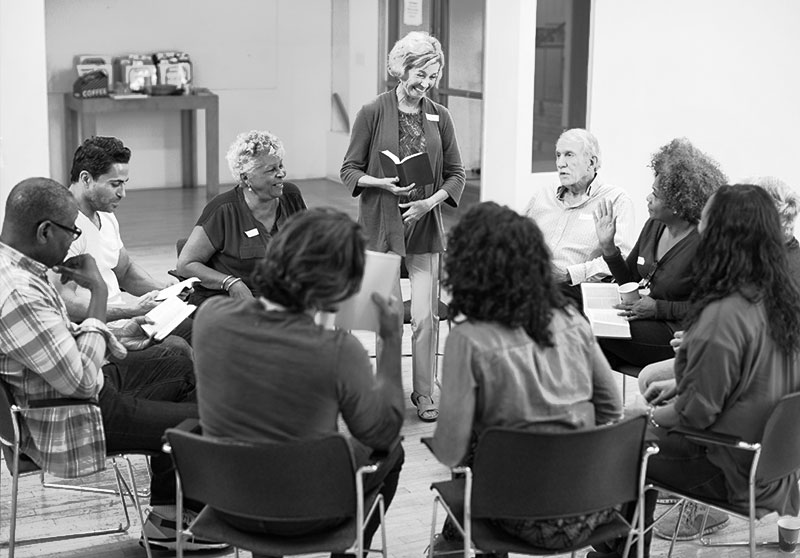Gender-based violence in society
In the last decade, the problem of gender-based violence has gained great visibility through the media and different movements that emerged to confront and repudiate such abusive behaviors. As a society, we have often ‘masked’ different forms of violence and naturalized them.
Very often we aggravate gender-based violence, especially against women.
Outwardly, people probably would express their agreement with gender-based violence prevention campaigns, but possibly if we examine their daily behavior, we will find actions that contradict these postulates. Very often, whether in a conscious or unconscious way through our language, decisions, or omissions, we aggravate gender-based violence, especially against women, in societies where a patriarchal culture predominates. This is evident in the high rates of femicides worldwide.
From the moment we are born, and as we grow up, we are bombarded by countless messages about what a girl and a boy should be like and what roles each of them should play respectively when they reach adulthood. Women are being stereotyped as sensitive, submissive, dependent and weak, with less capacity than men to carry out tasks that require leadership. It is said that ‘woman is an inferior being’, and she is held responsible for the violence she suffers with phrases such as ‘she is to blame’, or ‘she must have done something.’
In this way as a society, we are naturalizing violence through language. Words are so important! What comes out of our mouth sends messages that affect the lives of the other to affirm, build, help, stimulate, challenge, but also to hurt, discourage, and destroy. Every word we say influences the life of the other, for better or for worse. It is not only what we say that impacts the lives of the people around us, especially those over whom we have influence, but also the language we use to communicate what we want to say.

Gender-based violence in church
Evangelical churches as part of society are not exempt from the social problem of gender-based violence. There are two areas that I consider fundamental regarding this issue in communities of faith. On the one hand, we are not exempt because church people could suffer this type of violence at home, in their jobs, and through different situations of daily life. But, on the other hand, this problem is also present in the discourse of those who lead the faith communities.
Some faith communities act as facilitators of violence, without necessarily being intentional.
Some faith communities act as facilitators of violence, without necessarily being intentional. Patriarchy is an ideological predominant discourse in some evangelical churches. Women are to ‘accommodate’ the treatment by men and submit to their authority. Such attitudes are justified as being biblical and according to the will of God.
How will churches become facilitators of violence against women?
First, through a system of hierarchies where men and women cannot exercise equal roles. Men are placed in positions of authority and decision-making, while women who wish to exercise those same roles are not permitted to do so. For example, by not allowing women to preach or lead, we assume a certain ‘superiority’ of the man who then holds the same posture at home. On the contrary, we can find stereotypical roles of women within the church such as Sunday school teachers, prayer groups coordinators, or cooks.[1]
Second, in some cases gender-based violence can be sustained by applying certain texts in a direct way without considering the cultural framework in which they were given and how this affects their implementation. For example, the assertion that man is ‘head of the woman’ can serve, in a patriarchal culture, to legitimize man’s superiority over women. That certainly was not the intention of the original text. A literal interpretation of the text is not always true to the message the text intends to convey, and we run the risk of establishing dogmas that affect human dignity.[2]
Third, violence is facilitated by the lack of information in churches about gender-based violence. If this social problem is not discussed and not studied in depth, it can lead to different ways of exercising violence and many of them can be very subtle, attacking human dignity nonetheless.
Seek professional help from people trained in the subject and take the necessary measures required to preserve the life and dignity of those who are victims of violence.
Lastly, violence can be encouraged by ‘spiritualizing’ situations that require urgent help and treatment. It is believed that the aggressor ceases to be violent in a miraculous way by the power of prayer alone. Undoubtedly God can completely and miraculously change people and reverse complex situations, but while praying, it is necessary to also act. That is, seek professional help from people trained in the subject and take the necessary measures required to preserve the life and dignity of those who are victims of violence.
People’s lives are conditioned, among other things, by the knowledge acquired and information received throughout life. The learning obtained in the different areas where we develop and grow is later translated into our attitudes, way of thinking, and acting. What we have learned and experienced in the ecclesial community to which we belong, undoubtedly contributes to our formation as people of faith. The teaching that emerges from some pastors and leaders is later reproduced in the discourse in those who are part of that community, both for those who position themselves in a place of superiority and for those who accept it submissively.
It is a challenge for pastoral carers to be able to help prevent gender-based violence, detect it in time, accompany those who go through it, and be agents of peace and not act as facilitators of it.

What can we do as a church to prevent gender-based violence?
I would like to highlight three key actions:
 First, transforming beliefs at the leadership level. [3]
First, transforming beliefs at the leadership level. [3]
Many who are in charge of churches—pastors, ministry leaders, and others—think that everything is as they believe and that, therefore, it must remain that way. The problem must be worked from the root, that is, transforming these beliefs, to then changing behaviors and discourses. One way to achieve this is through holistic leadership training[4] which includes understanding gender-related social justice issues by professionals.
 Second, reflecting equality in a concrete way in the daily life of the church.
Second, reflecting equality in a concrete way in the daily life of the church.
Being part of a church where equality in man-woman relationships is promoted, for example, having both men and women in positions of authority, exercising decision-making, and taking on the role of a pastor, will pave the way for the non-naturalization of violence.
 Third, reviewing the presence of gender-related issues in liturgical celebrations.
Third, reviewing the presence of gender-related issues in liturgical celebrations.
Gender-based violence issues should be openly discussed and taught in the daily routine of ecclesial life. It is essential to be informed, to understand what the issues are, the different types of violent behavior, and to provide practical tools to detect it, policies to safeguard against it, and not to naturalize it.
Concluding reflection
Human dignity must be above any religious mandate. If we can demonstrate this in communities of faith in concrete ways, surely we will be agents of peace and create a space where women and men can feel safe, loved, and respected.
Human dignity must be above any religious mandate.
As Elsa Tamez explains, the Bible, interpreted androcentrically and patriarchally, has been a source of legitimacy to marginalize women in the church and in theology.[5] But we have also seen that when read from the perspectives of the oppressed and marginalized, it has been a source of liberation and life for many, including women. When applied to the church, we as communities of faith can be places of welcome, love, containment, and liberation. ‘Let us men and women reflect our original human constitution . . . to be in the image and likeness of God’, Elsa Tamez urges.[6]
Jesus left us the best role model. We need to be humble and acknowledge as churches that we have failed. We cannot go back in time and erase everything that could have been avoided, but the good news is that we can change the reality of many women from now on.
Endnotes
- Editor’s Note: The Cape Town Commitment https://lausanne.org/content/ctcommitment, Section II F 3, on ‘Men and Women in Partnership,’ acknowledges different biblical interpretations within the Lausanne Movement about specific male and female roles, but provides principles for positive engagement on behalf of the gospel.
- Editor’s Note: Within evangelical Christianity, there is a spectrum of theological positions on the relationship between men and women—including some described as complementarianism and egalitarianism. From some perspectives, a literal application of some passages may result in diminishing the dignity of women.
- Robert Dilts, Changing Belief Systems with NLP (California: Dilts Strategy Group, 2018).
- Editor’s Note: See article by Mary Ho, entitled ‘The Transcendent Culture of Servant Leadership’, in March 2020 issue of Lausanne Global Analysis, https://lausanne.org/content/lga/2020-03/transcendent-culture-servant-leadership.
- Elsa Tamez, ‘Hermeneutical Guidelines to understand Ga 3.28 and Co 14.34’, Journal of Latin American Biblical Interpretation (1993): 10.
- Catalina F. de Padilla and Elsa Tamez, The man-woman relationship in Christian perspective (Buenos Aires: Kairós, 2002), 44.

